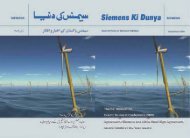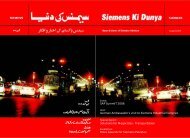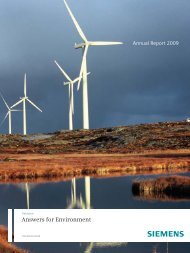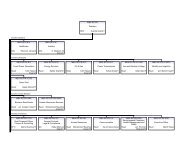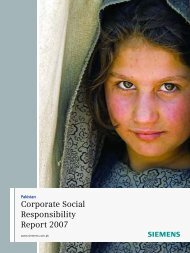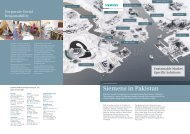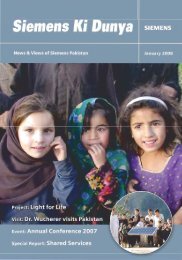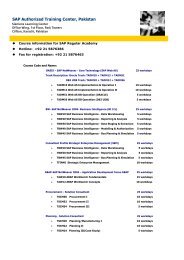Download - Siemens Pakistan
Download - Siemens Pakistan
Download - Siemens Pakistan
Create successful ePaper yourself
Turn your PDF publications into a flip-book with our unique Google optimized e-Paper software.
Notes to the Financial Statements<br />
133<br />
3.21 Business combinations<br />
Business combinations are accounted for by applying the purchase method. The cost of acquisition is measured as the fair value of the asset given,<br />
equity instruments issued and the liabilities incurred or assumed at the date of exchange, plus costs directly attributable to the acquisition.<br />
Identified assets acquired are recognised at fair value at the acquisition date, irrespective of the extent of any minority interest. The excess of cost<br />
of acquisition over the fair value of identifiable net assets acquired is recorded as goodwill.<br />
3.22 Amendments to published standards and new interpretations effective in 2008<br />
- Amendment to IAS 1, 'Presentation of Financial Statements - Capital disclosures'; introduces new disclosures about the level of an entity's capital<br />
and how it manages capital. Adoption of this amendment has only resulted in additional disclosure given in note 41 to the financial statements.<br />
- IFRIC 10 'Interim Financial Reporting and Impairment', prohibits the impairment losses recognised in an interim period on goodwill and<br />
investments in equity instruments and in financial assets carried at cost to be reversed at a subsequent balance sheet date. This IFRIC does not<br />
have any impact on the Company' financial statements.<br />
- IFRIC 11 - IFRS 2 - 'Group and Treasury Share Transactions' provides guidance on whether share-based transactions involving treasury shares or<br />
involving group entities should be accounted for as equity settled or cash settled share-based payment transactions in the stand alone financial<br />
statements of the Company. This IFRIC does not have any impact on the Company's financial statements.<br />
3.23 Standards, interpretations and amendments to published accounting standards that are issued but not yet effective<br />
The following standards, amendments and interpretations of approved accounting standards are only effective for accounting periods beginning<br />
on or after October 1, 2008 and except for additional disclosures are not expected to have a significant effect on the Company's financial<br />
statements or are not relevant to the Company:<br />
- IFRIC 12, 'Service Concession Arrangements' (effective from annual periods beginning on or after January 1, 2008). IFRIC 12 applies to<br />
contractual arrangements whereby a private sector operator participates in the development, financing , operations and maintenance of<br />
infrastructure for public sector service.<br />
- IFRIC 14, 'The Limit on a Defined Benefit Asset, Minimum Funding Requirements and their Interaction' (effective from annual periods beginning<br />
on or after January 1, 2008). IFRIC 14 provides guidance on assessing the limit in IAS-19 on the amount of surplus that can be recognised as an<br />
asset. It also explains how the pension asset or liability may be affected by a statutory or contractual minimum funding requirement.<br />
- IAS 29, 'Financial Reporting in Hyperinflationary Economies' (effective from annual periods beginning on or after July 1, 2008). The objective of<br />
this standard is to establish specific standards for enterprises reporting in the currency of a hyperinflationary economy.<br />
- IFRS 7, 'Financial Instruments: Disclosures' (effective from annual periods beginning on or after July 1, 2008). This standard requires extensive<br />
disclosures about the significance of financial instruments for an entity's financial position and result of operations, and qualitative and<br />
quantitative disclosures on the nature and extent of risks arising from financial instruments. It combines disclosure requirements from IAS-32,<br />
Financial Instruments: Presentation, and IAS-30, Disclosures in the Financial Statements of Banks and Similar Financial Institutions, and adds new<br />
disclosure requirements.<br />
- IFRIC 13, 'Customer Loyalty Programmes' (effective from annual periods beginning on or after July 1, 2008). IFRIC 13 addresses the accounting<br />
by entities that operate, or otherwise participate in, customer loyalty programmes for their customers.<br />
- IFRIC 16, 'Hedges of a Net Investment in a Foreign Operation' (effective from annual period beginning on or after October 1, 2008). IFRIC 16<br />
provides that the presentation currency does not create an exposure to which an entity may apply hedge accounting. It also specifies that hedging<br />
instrument(s) may be held by any entity or entities within the group. Further, it also clarifies that foreign translation reserve in respect of the<br />
hedging instrument, IAS 21 must be applied in respect of the hedged item.<br />
- IAS 1, 'Presentation of Financial Statements' (effective from annual periods beginning on or after January 1, 2009). The objective of revised IAS<br />
1 is to aggregate information in the financial statements on the basis of shared characteristics and is aimed at improving users' ability to analyse<br />
and compare the information given in the financial statements. IAS 1 sets overall requirements for the presentation of financial statements,<br />
guidelines for their structure and minimum requirements for their contents. It introduces the requirement to include in a complete set of financial<br />
statements, a statement of financial position as at the beginning of earliest comparative period whenever the entity retrospectively applies an<br />
accounting policy or makes a retrospective restatements of items in its financial statements, or when it reclassifies items in its financial<br />
statements.<br />
- IAS 23, (Amendment) 'Borrowing Costs' (effective from annual periods beginning on or after January 1, 2009). It requires an entity to capitalise<br />
borrowing cost directly attributable to the acquisition, construction or production of a qualifying asset as part of the cost of that asset. The option<br />
of immediately expensing those borrowing costs will be removed.<br />
- IFRS 2, (Amendment) 'Share-based Payment' (effective from annual periods beginning on or after January 1, 2009). It clarifies the definition of<br />
vesting conditions, introduces the concept of non-vesting conditions, requires non-vesting conditions to be reflected in grant-date fair value and<br />
provides the accounting treatment for non-vesting conditions.<br />
- IFRS 8, 'Operating Segments' (effective from annual periods beginning on or after January 1, 2009). IFRS 8 replaces IAS-14, 'Segment Reporting'.<br />
IFRS 8 requires a 'management approach', under which segment information is presented on the same basis as that used for internal purposes.<br />
- IFRIC 15, 'Agreement for the Construction of Real Estate' (effective from annual periods beginning on or after January 1, 2009). IFRIC 15 provides




